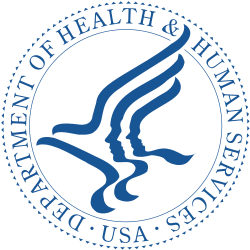This article may rely excessively on sources too closely associated with the subject , potentially preventing the article from being verifiable and neutral.(April 2018) |
 HRSA Logo | |
| Agency overview | |
|---|---|
| Formed | October 1, 1982 [1] |
| Preceding agencies |
|
| Jurisdiction | Federal government of the United States |
| Headquarters | North Bethesda, Maryland (Rockville mailing address) |
| Employees | 1,996 |
| Annual budget | US$12.1 billion (2021) |
| Agency executives |
|
| Parent agency | United States Department of Health and Human Services |
| Website | hrsa.gov |
| Footnotes | |
| ("HRSA" is pronounced /ˈhɜːrsə/ HUR-sə by initiates; /ˌeɪtʃɑːrɛsˈeɪ/ "H-R-S-A" is an often-heard spelling pronunciation) | |
The Health Resources and Services Administration (HRSA) is an agency of the U.S. Department of Health and Human Services (HHS) headquartered in North Bethesda, Maryland. It is the primary federal agency for improving access to health care services for people who are uninsured, isolated or medically vulnerable.
Contents
- Functions
- Organization
- Primary health care
- HIV/AIDS
- Maternal and child health
- Rural health
- Health workforce
- Healthcare systems
- History
- Predecessors
- Establishment and later history
- References
- External links
Comprising six bureaus and twelve offices, HRSA provides leadership and financial support to health care providers in every state and U.S. territory. Its grantees provide health care to uninsured people, people living with HIV/AIDS, and pregnant women, mothers and children. They train health professionals and improve systems of care in rural communities.
HRSA oversees organ, bone marrow and cord blood donation. It supports programs that prepare against bioterrorism, a program to compensate people who experience vaccine adverse events, and maintains databases that protect against health care malpractice and health care waste, fraud and abuse.
As part of the announced 2025 HHS reorganization, HRSA's components are planned to be integrated into the new Administration for a Healthy America. [3]

